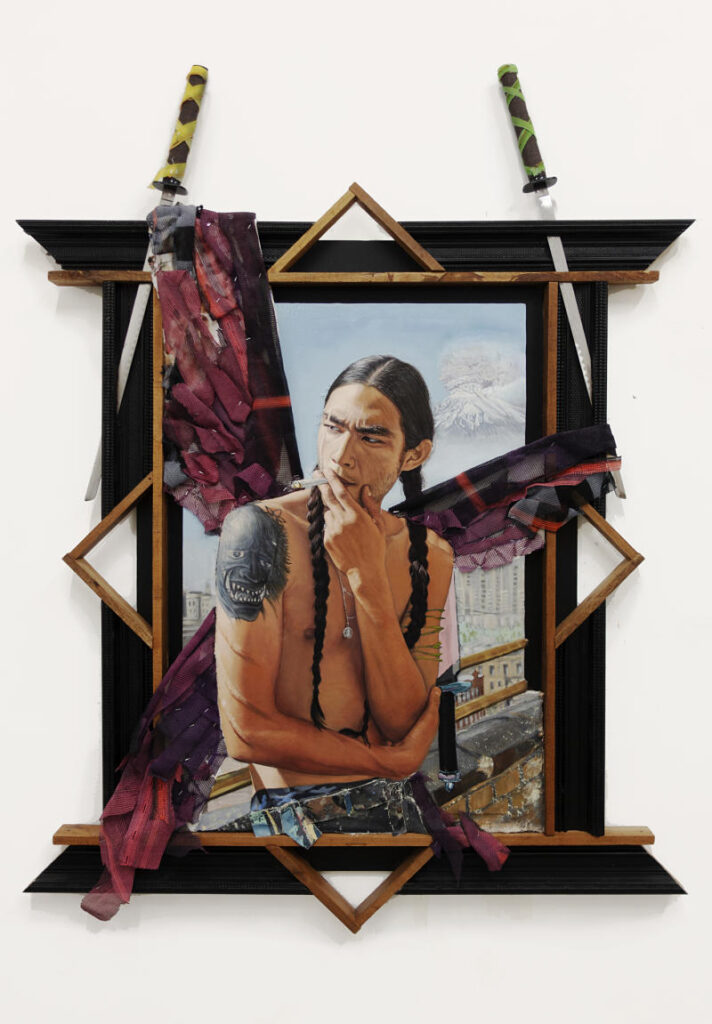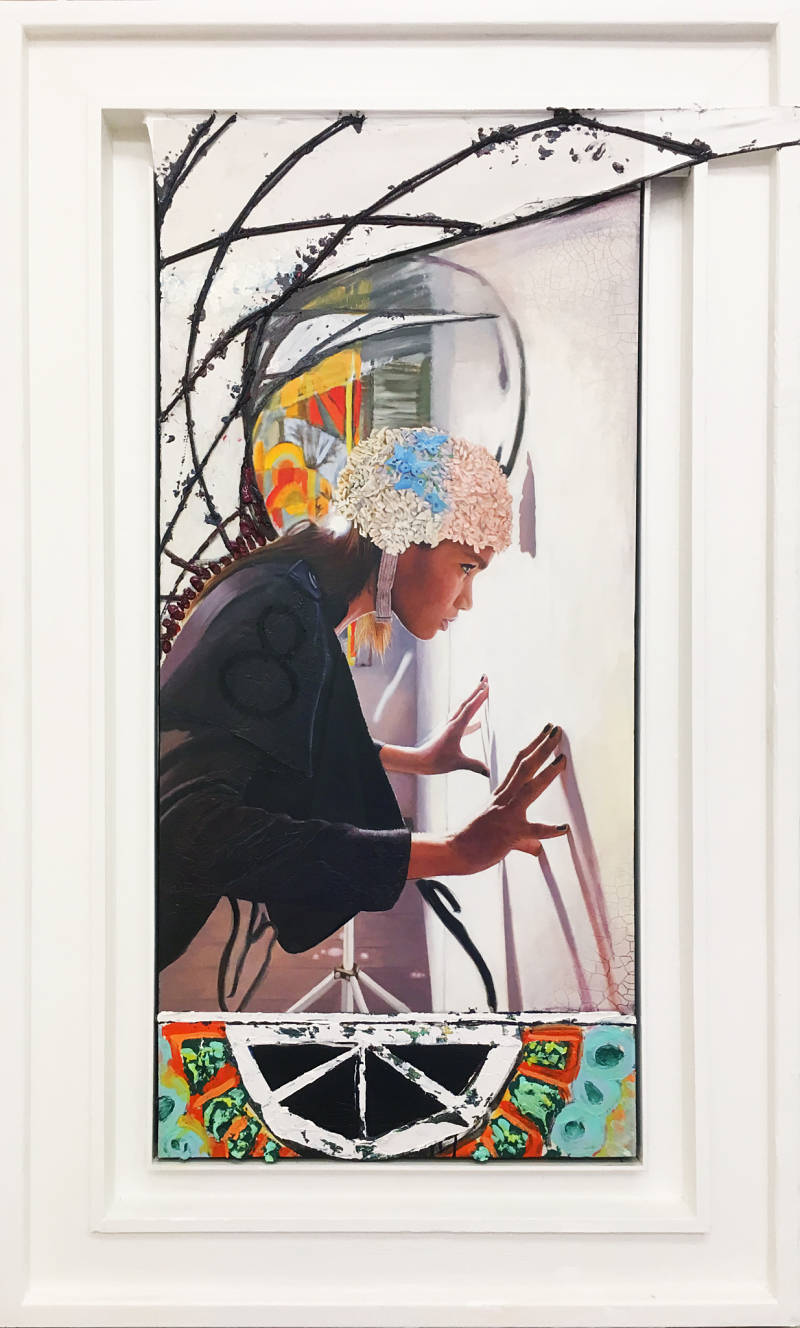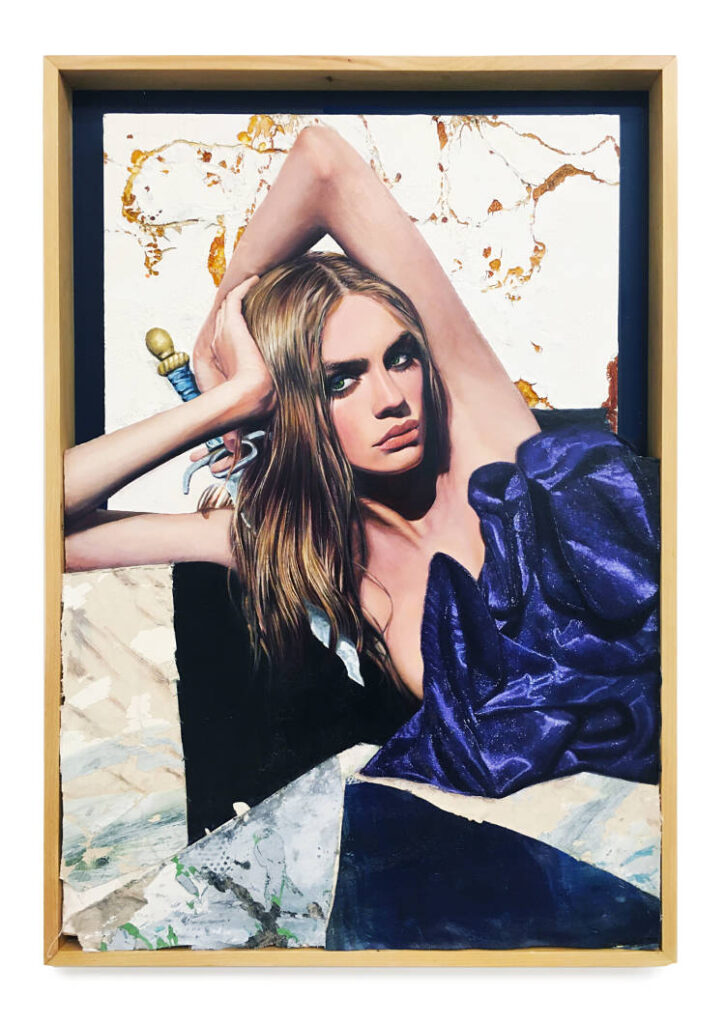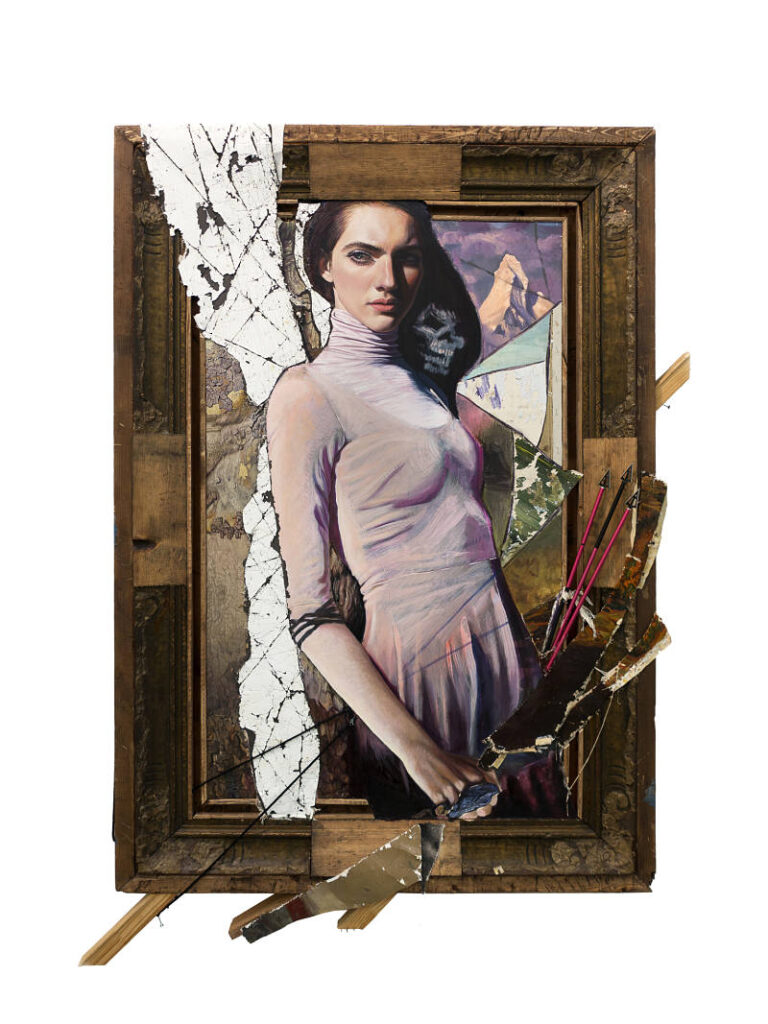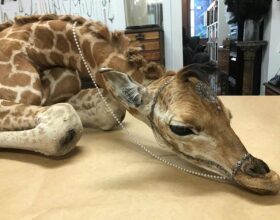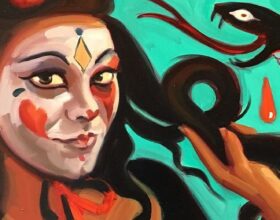James Gortner is a painter based in New York City. I first met James while touring MANA Contemporary’s open studios. It was there that I first fell for his work and his wonderfully illustrative explanations behind his process. We have remained friends ever since. A graduate of Columbia’s MFA program, James is skilled in multiple mediums – as well as genres.
I have seen only a few of his abstract pieces in person and was impressed that they were created by the same person who I knew so well. It’s not easy to create such diversity in one’s work. James does just that, and more.
We hope you enjoy our exclusive interview with James Gortner!
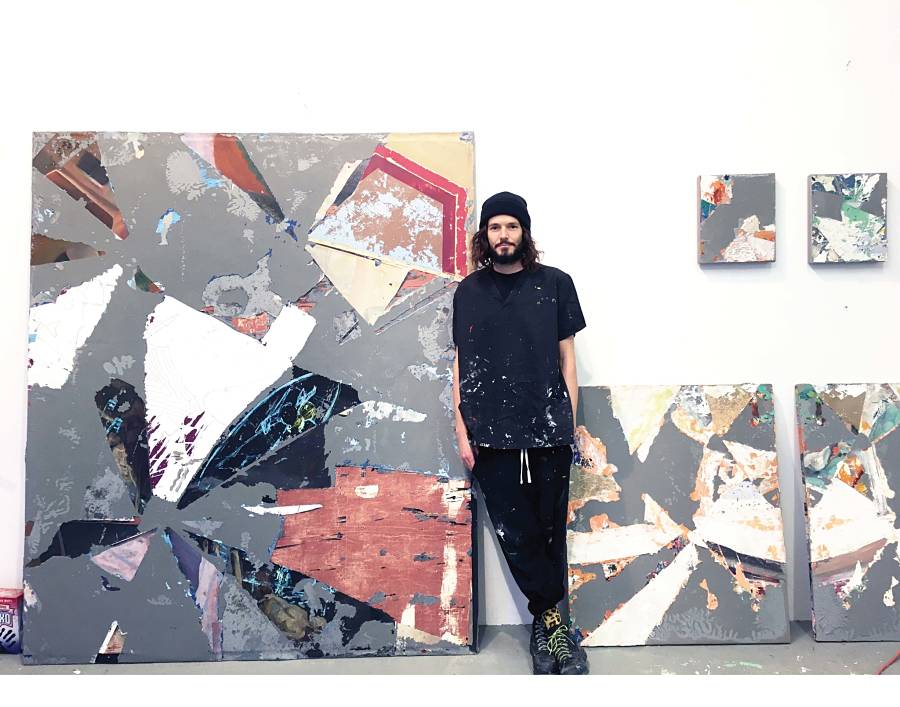
Like the wet reclaimed paint from tubes and buckets I use, these found paintings were done for, or essentially dead. I bring them back into the fold. Found paintings, and paint, the way I use them, represent the ideal allegorical material for transmutation.
What a pleasure seeing you at MANA Contemporary Open Studios. I was immediately drawn to your studio seeing all the beautiful mixed media paintings, particularly those exploring the figurative. Can you share with our readers something about your working process?
Thank you, Nicole. Like a lot of old fashioned, traditional oil paintings, these are made directly on wood panel. The only difference is that I create these from 100% reclaimed lumber so the paintings get an eco friendly start. Then I sculpt each panel’s surface using more wood, foam, canvas and staples before using mostly reclaimed oil paint to cover most the surface and render the figure. At the same time, I assemble and paint over found paintings made by other artists in the work as well lending an element of abstraction to the narrative. Some of that content peeks through. Everything is mounted on a large panel. They are made very strong to last forever. It’s the brick house, Nicole!
Lastly, I design and build a frame for the painting from more reclaimed lumber. For me the frame completes this kind of painting, lends safety and more dimension to the work.
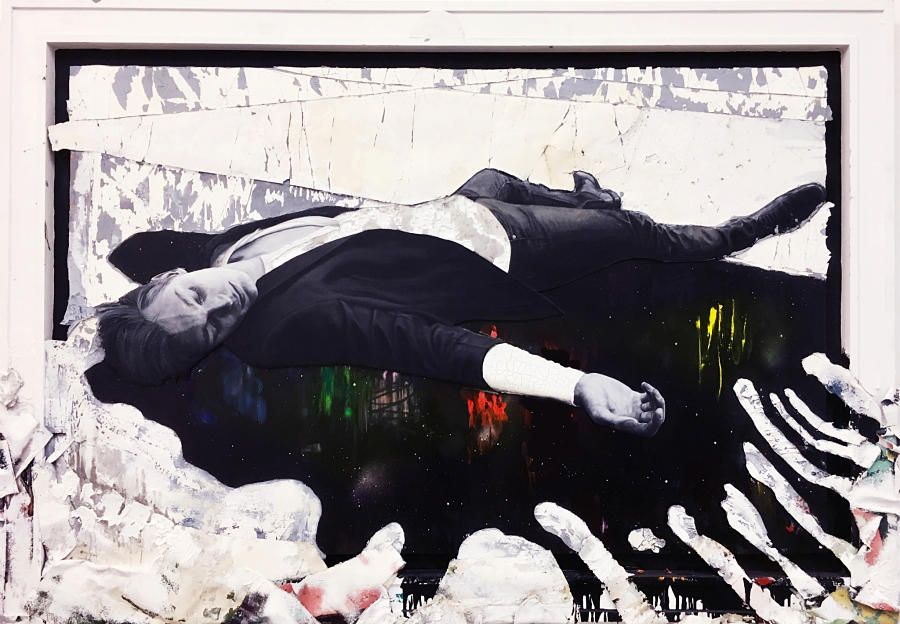
I love it. In this case, what is reclaimed paint? What are found paintings? And can you talk about the dimension? That seems to be an important part of the process.
80% of the paint I use in these is reclaimed. meaning it came used from a paint supply store or individual art supply owner who either wanted to give it away, or throw it in the landfill. Oil and acrylic paint is not good for the environment when put in the landfill so it can’t be legally thrown away in New York. I provide vendors an alternative to risking fines for tossing it. I’ve received and used hundreds of gallons and tubes from my suppliers. I think I invented all this. I don’t know for sure, but it feels organic to me.
I’m a collector. “Found paintings” are paintings I collect, that were made by another artist -that I then scrap for content and color swaths. Most pieces I collect are failed works, or works that artists or owners didn’t want to take with them for whatever reason. There are endless sources for these paintings. I’ve been saving paintings and doing this for 20 years.
Like the wet reclaimed paint from tubes and buckets I use, these found paintings were done for, or essentially dead. I bring them back into the fold. Found paintings, and paint, the way I use them, represent the ideal allegorical material for transmutation. One of my paintings might contain pieces from tens or hundreds of paintings. Those tens of painters I salvaged, I took pieces out of, or I covered over, might have taken ideas and dreams from still more art or sources before them. It goes on and on -art is continuous- and I, for my part, I bring to life any and all art. I collect found paintings, including works I find in New York art school studio clean-outs, colleagues studios, vintage stores, flea markets, old storage units, and my own past paintings I wish to transform.
I take them off the stretchers, cut them up and mash them up for aesthetic purposes. I transform them harshly, but also preserve them. Pieces of these lost paintings get a new start as part of a next story. Through the process of incorporating old and new paintings of all genres, along with my different painting techniques, I am able to create works of art that time travel through decades, centuries, and even dreams to create the context I like. This multi-authored assemblage is then allegory for a patchwork identity in my portraits of people and my History Paintings of mythical creatures, gods and goddesses. I paint further into surface and assemblage until it all starts to jive. I like deep dimensional backgrounds and foregrounds. The raised surfaces combined with optical painting to heighten a dimensional effect. The materials give the work another kind of spirit depth. That’s the true dimension I believe.
In all the ways I paint, I’m drawn to the subject of transformation. Passing into and from something else. I also like thinking of self-expression, interconnectedness of people, their collective subjectivity, how we are connected on the level of quantum physics, through time, social conditioning, shared spirituality, a collective imagination, our dreams, and finally how this manifests in our senses of identity.
Do you have a favorite subject matter to paint? If so, what makes you drawn to it?
For me, a lot of the subject matter is transformation. Years ago, I told my mentor, the pictures generation artist Matt Mullican, about how I made projects depending on what was going on in my life (like most artists do). How I once lived in my car, how I once made art in an abandoned cemetery building for two years, or how then, later, I made art while in Ivy League art school. Matt listened intently to my stories, how people I meet effect the work, and how one project always leads into the next. I remember him saying something to me, which resonated deeply, “Your Art, is like your vehicle”. He meant like the 63 Chevy I lived in, and art is where it goes from there.
In all the ways I paint, I’m drawn to the subject of transformation. Passing into and from something else. I also like thinking of self-expression, interconnectedness of people, their collective subjectivity, how we are connected on the level of quantum physics, through time, social conditioning, shared spirituality, a collective imagination, our dreams, and finally how this manifests in our senses of identity. It’s a continuous state of transforming. These days I am painting winged mythical creatures like gods, angels and faeries to approach this transformation because these myths are transformed and retold through large expanses of time and people to be with us here. Because these myths flew, I can now remix these histories into my paintings and make them contemporary.
I find it amazing that the best of these myths, even contemporary myths like “Contemporary Art”, have built into their narratives the mystical transformation of a human or protagonist’s earthly circumstances. These mythical creatures are in order to invoke action and agency. Crazier still is that these same supernatural powers, were bestowed on these super beings by the collective human imagination!
The snake bites its tail! That’s what I want to happen when I view a work of art. I want this badass to take me somewhere and change some stuff around in me -and out of me! I want a mystical experience for a subject -a transcendental occurrence. Artists are like shaman, moving circumstances and material around in the ether. Just see the way any artist in art history used art to change their reality, or someone else’s reality in possession of the art. The viewers are in motion, coming from something, and going onto something else.
See again, the subject for me goes back to transformation and mobility. Art is a vehicle for everyone to communicate across time. I’m a transformer of art. Art is the transformer of me. Hands on the wheel -everybody! The wheel is right now. The paintings I make are tire tracks that sprout trees. That’s the subject.
When we last spoke, you mentioned that all art is like collaboration, as nothing is purely owned by us. Can you speak on this subject a bit further?
In my opinion, all art is collaboration; that’s because all art came from other art that came before. There is no known starting point for any one work of art. This can be explained best in the scientific law of conservation of energy; “Energy cannot be created or destroyed, only transformed”. That is vulnerability.
I see collaboration and art in these terms: Art cannot be created or destroyed -only transformed. Like anything, paintings are objects made of energy- maybe more so. Art usually holds still, but art is in a constant state of change with itself and its viewer. Even after a painting is ‘finished’ it continues to transform every time someone new looks at it- via viewer perception- so it’s never finished either. It came from something, and it’s going to turn into something else with other people. That seems like a mutually willing collaboration to me.
Even when I’m alone in my studio, I’m not alone. That place is especially loaded with spirits. It’s ongoing collaboration. But that’s just it, I am not enough alone to say art is an ongoing collaboration, and turn this into part of the art world’s accepted group constructs, many more would have to agree with me. This is what is so subversive about the way I see art –physically interconnected.
Get this. Also, scientists say now there is probably no “free will”, so the decisions I make even as an artist are predetermined results of evolutionary algorithms. That’s the latest dig to the lone self. What bigger collaboration can there be, then to have art making decisions made by the millions of years of DNA that came before us? Mostly what I learned on the African Savanna where my ancestors spent most of their time evolving, but also a little after that spent surviving the expansion as a species into other continents. I was making my paintings before I was born?!! Boom! That’s going to be a problem for “alone” artists to swallow. But I’ve been there before.
So I tread lightly here. And wait for the tide to shift, and winds to change. And I’ve been there before.
How many hours do you generally work on one piece?
Years, up to 10 years is not uncommon for me. But that is just how long I worked on it. Many paintings I cut up, transform and paint over as raw material were fabricated long before I was even born. I think my work will continue to evolve after I’m dead when viewers and curators reinvent the meanings to reflect their own times and their current view of our times, and they will mix-in their own personal identities and piece together a new interpretation of my work. The work and transformation is continuous. That’s the true power. So I work on an artwork forever is what I’m saying.
Do you have mentors or any particular artists you admire that influence you work?
I have many. Art has such a rich history and I’ve known and talked with great artists.
My kids have been my mentors. These days art collectors are great mentors to me. Among them, fellow artists, doctors, investors, actors, politicians, musicians, entrepreneurs and so many rock stars. I learn from them about life and art. They see things early. At this point, it’s a kind of fearless person who gravitates towards collecting my work. It’s not for everyone.



